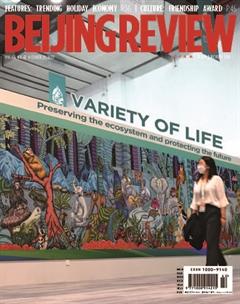Aksu Hits the Books
By Wen Qing

On the afternoon of September 16, 18-year old Nurbigul Tohti sat quietly in the art room of No.4 Middle School of Kuqa, part of Aksu Prefecture in south Xinjiang Uygur Autonomous Region. Her eyes were fixated on the face sketch in front of her. The room was immersed in silence, except for the soft sounds of pencils brushing against the canvas.
“I like taking these optional drawing classes. It is a great time to detach myself from the heavy compulsory curriculum studies and it may also help me get into a better university,” Nurbigul, a high school senior, told Beijing Review. Her dream university is in Xian, a time-honored city with magnificent historical places she often sees on Douyin, the domestic version of TikTok.
Like Nurbigul, students in both primary and middle schools are all encouraged to choose several courses related to their personal interests, including calligraphy, drawing and dancing. The courses, taught by professionals recruited by the schools, are free of charge.
This is part of Aksu Prefectures efforts to further improve its education quality. In recent years, local governments across Xinjiang have moved education to the top of their development agenda, aiming to not only give young people a promising future, but also equip them with a moral compass to eradicate the roots of terrorism and extremism.
More than knowledge
“We give students the knowledge to prepare them for the gaokao, the university entrance examination, and help them plan for the future. More importantly so, schools and teachers protect them from the influence of extremist thought,” Turghun Hasan, a high school teacher at the Experimental High School of Xinhe County in Aksu, said.
“Young people mostly lack a comprehensive and objective understanding of their surroundings, which means they need guidance. Most of our students come from rural areas, and their parents often did not receive much education, leading some to get caught in the traps of terrorism,” he added.
Multiple terrorist attacks in previous years exhibited that the young people of Xinjiang had become a target of terrorist influence. For example, on July 30, 2014, 74-year-old Mullah Juma Tayier, the prestigious and respectable imam of Chinas largest mosque, the Id Kah Mosque, was brutally stabbed to death by a 19-year-old terrorist—instructed by an 18-year-old “mentor”—after the morning Fajr prayer.
According to Turghun, acquiring language skills is another important task for all students at the school, where many students are from ethnic minorities. “As a Uygur myself, I know all too well the importance of mastering standard Chinese (Putonghua). I used to perform poorly in academics because I couldnt fully understand what the teachers were saying,” he said.“For Uygur kids, they must learn Putonghua, not just for now but also for their future; their lives are not limited to Xinjiang. Beijing, Shanghai, Shenzhen... If they can speak Putonghua, they will have more choices later on in life.”

